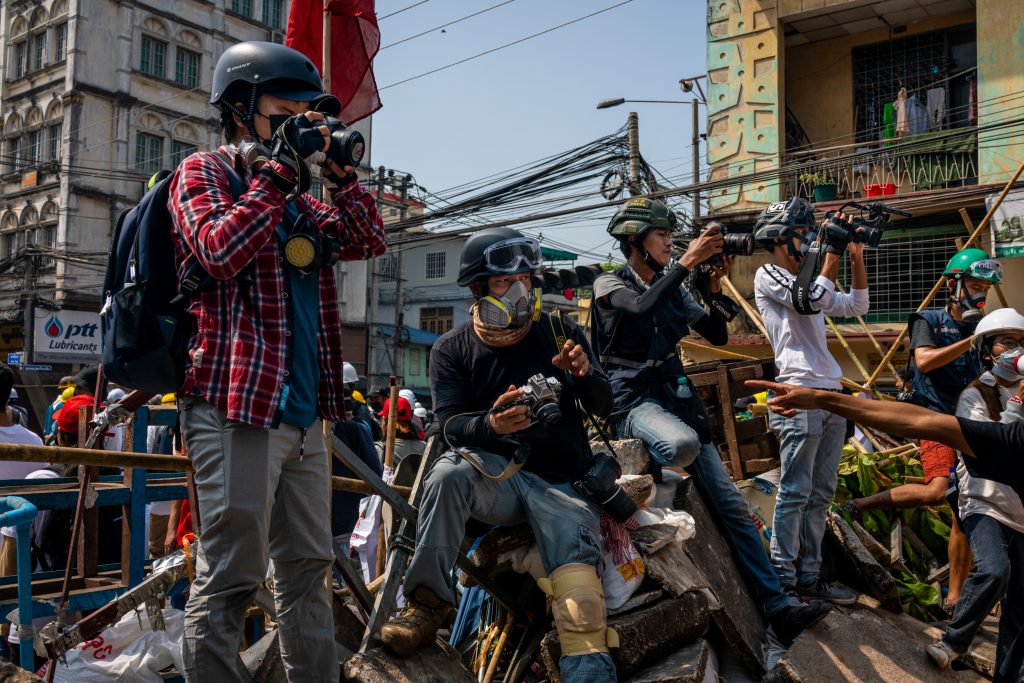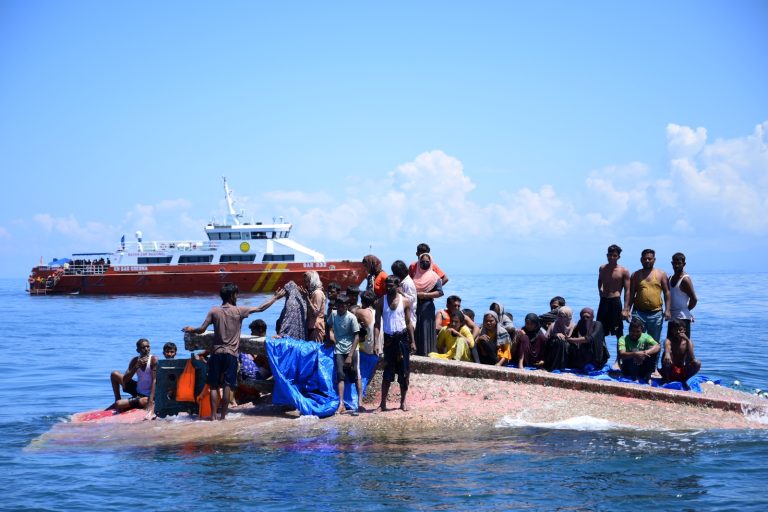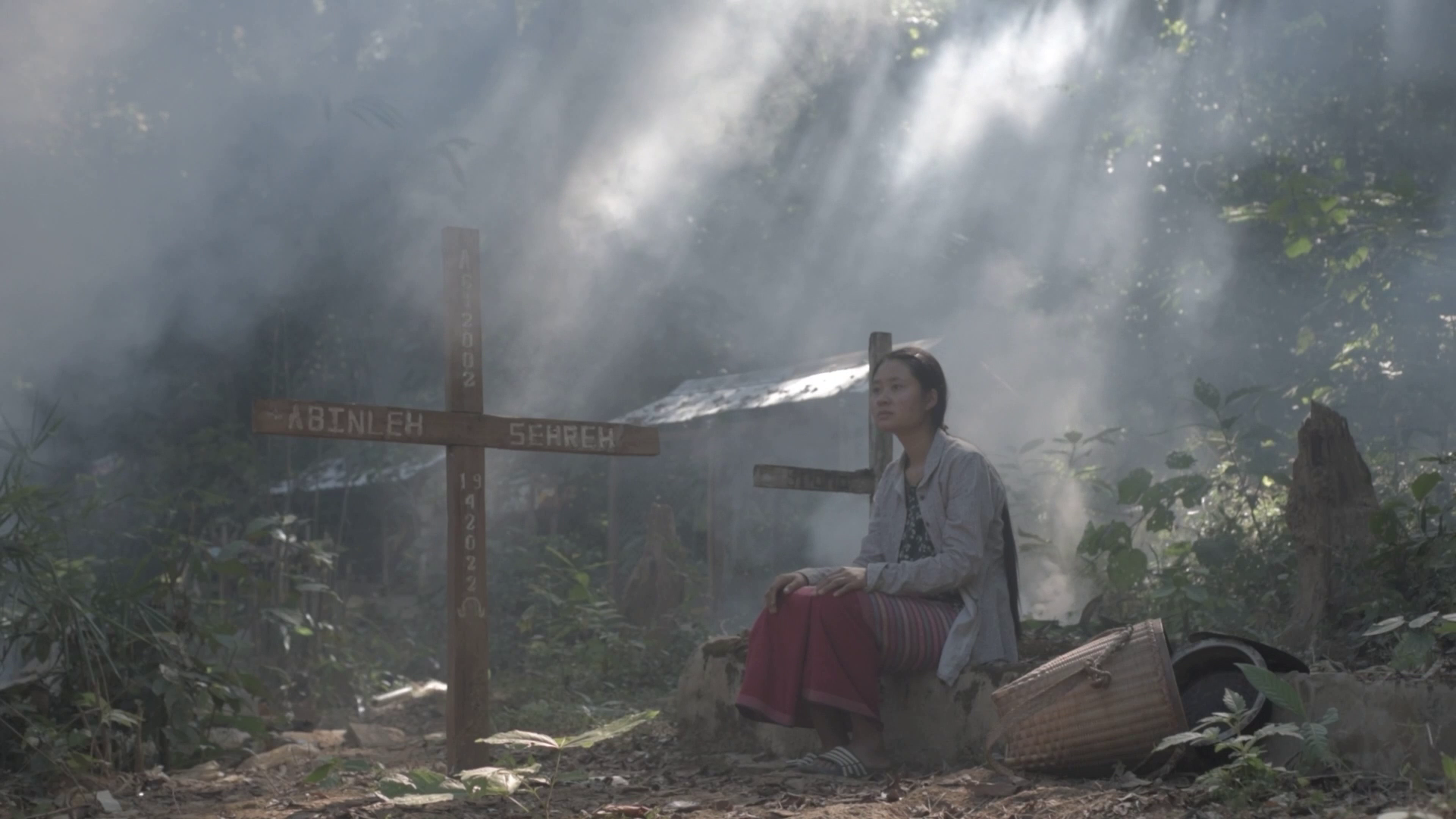Despite being targeted by the junta, Myanmar independent media continues to deliver to an information-hungry people, as publishing and consumption habits fracture into pro-and-anti-junta camps.
By FRONTIER
The Myanmar junta’s well-documented assault on local media and journalists has transformed the media landscape.
The military regime, also known as the State Administration Council, has killed at least three journalists since the coup, two of whom allegedly died while being tortured. It has also arrested at least 115 journalists, jailed 57 and convicted 14, according to a report by Reporters Without Borders (RSF) on the one-year anniversary of the coup.
The junta has banned 12 independent media outlets including 7Day, Myanmar Now, Khit Thit, Mizzima and the Democratic Voice of Burma. Many other media outlets have suspended their print publications, including Frontier, while others have shut down entirely, like the English-daily The Myanmar Times. Some of them have had their offices raided by security forces.
A number of smaller outlets have closed. Many journalists and editors have gone into hiding or fled abroad. Media consumption habits and attitudes towards the media are also changing.
The Committee to Protect Journalists (CPJ) reports that globally Myanmar became the second-worst jailer of journalists in 2021, behind only China.
Opinions on sensitive issues such as Rohingya identity may be slowly changing, but due to the military’s extensive propaganda campaigns, the public are now starkly divided into two camps when it comes to the media they consume: pro-military and pro-democracy.
Going for big lies
The regime’s attempts to control the press and communicate a pro-military narrative have been exhaustive but largely unpersuasive.
On June 30 last year the junta’s Ministry of Information used the Global New Light of Myanmar to announce they had banned local media from using the words “junta” and “coup” and warned foreign media outlets not to use these words either. Few, if any, independent media outlets have respected the prohibition.
The junta has used the media it controls to portray a level of approval and support for the military that appears far from reality. It has recently taken to publishing stories purporting to show a return to normalcy in cities like Yangon and Mandalay, despite reports of near daily bombings in the cities and airstrikes continuing unabated in Kayin State and elsewhere.
During Thingyan, the military staged celebrations which were portrayed in regime-controlled media as hugely successful but were reported by observers as largely empty save for the attendance of military families.
The junta has been airing anti-resistance propaganda in a wide range of state-controlled TV channels, newspapers and pro-military media outlets, issuing a press release on December 21 accusing the pro-democracy movement of “undermining peace and stability of the State”. It was published by the GNLM alongside graphic photos of supposed victims of the pro-democracy groups, which have now been declared “terrorists”.
Despite the visible arrests and crackdown on the media, the military’s information minister U Maung Maung Ohn discussed “Ensuring the rights of journalists and protecting freedom of media,” during a dinner with members of the Myanmar Press Council on November 24 last year, as reported by the GNLM. Shortly after the coup, the MPC was rocked by a mass walkout of members who were then replaced with pro-military figures.
The government under Daw Aung San Suu Kyi’s National League for Democracy party had its own shortcomings when it came to Myanmar’s press freedom. Most famously was the arrest of Reuters reporters Ko Wa Lone and Ko Kyaw Soe Oo, who were imprisoned for investigating the killings of Rohingya people by military forces. The Noble laureate defended the arrests saying “they have broken the Official Secrets Act” in comments she made during the World Economic Forum in Hanoi in 2018.
Ms Gwen Robinson, Editor-at-Large at Nikkei Asia, said that she has witnessed an “extraordinary evolution of Myanmar media” since she began covering the country in early 2011. “Censorship was pervasive and absolute during my first visits in early 2011, I remember visiting The Myanmar Times and the news editor showed me copy that had been returned by the censorship authorities with big red pencil marks through various lines,” she told Frontier on April 21 via email.
“Now, the SAC has gone further than the junta under Than Shwe or any other previous regime. Instead of just censoring, they have destroyed independent media – revoked licenses, targeted TV reception dishes, and tried to shut down the internet. They have jailed or harassed journalists. At least several media have been tortured and some have been killed,” she added.
“There is obviously a ‘playbook’ from the previous era but this junta has gone way beyond that, it makes up its own rules. It is generally not out to censor, it’s out to destroy any independent media,” Gwen Robinson told Frontier.
In January, the junta also considered criminalising the use of Virtual Private Networks (VPNs) which people have been using to circumvent banned websites such as Facebook and retain anonymity online. Earlier in December, the military doubled mobile internet usage costs and added a tax on buying new SIM cards in an effort to restrict the sharing of information.
Despite the extensive efforts by the junta to use and control the media, they appear to have convinced few people outside of their circle of supporters. They are frequently mocked for their propaganda efforts on social media, and after what people have witnessed during and after the coup, nobody is buying what they’re selling.
Former media translator Ko Maung Kyaw* told Frontier he thinks the military propaganda is just designed to legitimise their takeover.
“They want to show the world that the situation in the country has become so terrible that the Tatmadaw is the only saviour in town,” he said. “You have to remember, Hitler once said if you are going to lie, go for a ‘big lie’, as people always think one would not lie on such an unprecedented scale.”
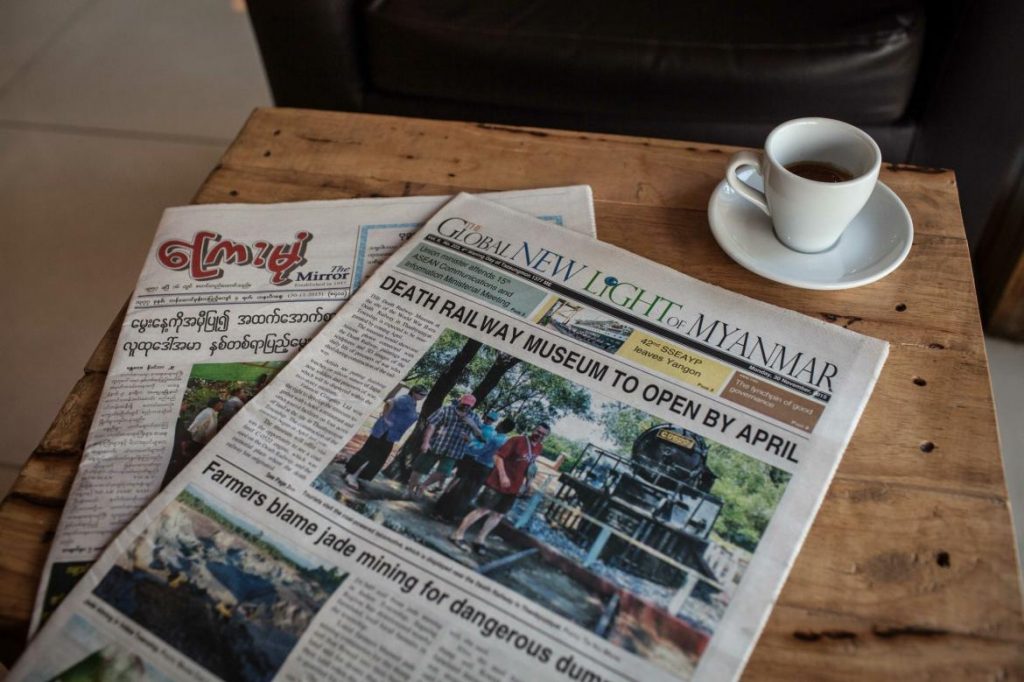
Compromising complexity
Media consumption habits in Myanmar have now split into two camps: some people get their information exclusively from the independent press and citizen journalism sources online, and a much smaller group only from military-controlled media. It has led to a social media “bubble effect” in which people only see articles that affirm their pre-existing beliefs.
“The problem with social media is you choose what you want to see, and the algorithm will only show what you want to see from them on. If you are a military supporter, your Facebook friends will also be supporters, and others will block you. And you will only see SAC’s propaganda. This is the tragedy of Myanmar that our version of the internet is a social media platform,” said Ma Sint, a young woman from Yangon, on April 22.
In addition, activists worry that reporting by independent media outlets has been so focused on reporting on the junta’s violent and repressive takeover that they have rarely turned their critical lens towards the National Unity Government and the pro-democracy movement. Reporting on the NUG is largely uncritical, and their actions are rarely questioned by the media.
“It’s not surprising that what is left of our independent media after suffering from a year of violent censorship is primarily focused on covering the SAC’s repression of the public. Nevertheless, it would be useful to see more media analysis of the NUG too, given that increased public awareness also leads to more public engagement and better decision-making,” said Ma Yin Yadanar Thein from Free Expression Myanmar.
Ko Thura Maung*, a Myanmar-focused analyst, echoed her views. “The overwhelming majority of people and media support the NUG, and want them to win. But the reality is there is also a culture that has emerged that the NUG should not be criticised ever for their failings. Any criticism is met with strong social media reaction, and constructive criticism is typically not welcomed,” he told Frontier via Signal on April 23.
There are also significant challenges facing independent media to get the story right in the post-coup era, which is limiting the type, quality and volume of stories that are getting published by professional media outlets. Fact-checking may require finding multiple sources willing to confirm events to the journalist, when it is now often difficult to find even one person willing to talk to media. Basic journalism tasks like conducting interviews now pose a security risk for both the source and the reporter.
A senior editor from a Myanmar media outlet who has worked in the industry for over a decade spoke to Frontier online on April 21 anonymously due to fears for his security.
“It’s one of the basics to identify yourself as a journalist before an interview, but you can’t identify yourself now. That’s difficult for building trust between the journalists and their sources,” he said. “There are times where it’s difficult to get the facts, so it’s hard to present a story. There are also times when there are hard facts with no source but you have to publish the story. There are sometimes sources but few facts.”
Robinson from Nikkei Asia noted the rise of citizen journalists who capture many of the important stories and footage on the ground, and a “strong trend” of smaller local publications stepping up, especially in the ethnic areas such as the Mekong News, Chindwin Times and the Kantarwaddy Times.
“There is also much more funding available for these outlets, as well as a new sense of unity as it seems so many of these online publications, commentaries, and images and videos are against the regime. You could say independent media is alive and thriving – thanks to the coup,” she said.
With both sides of the media continuing to focus their attention on pro-and-anti-regime stories, complexity is the victim. While pro-military outlets are focused on overt propaganda, it’s up to the independent media to show they understand nuance and can guide readers through politically challenging times.
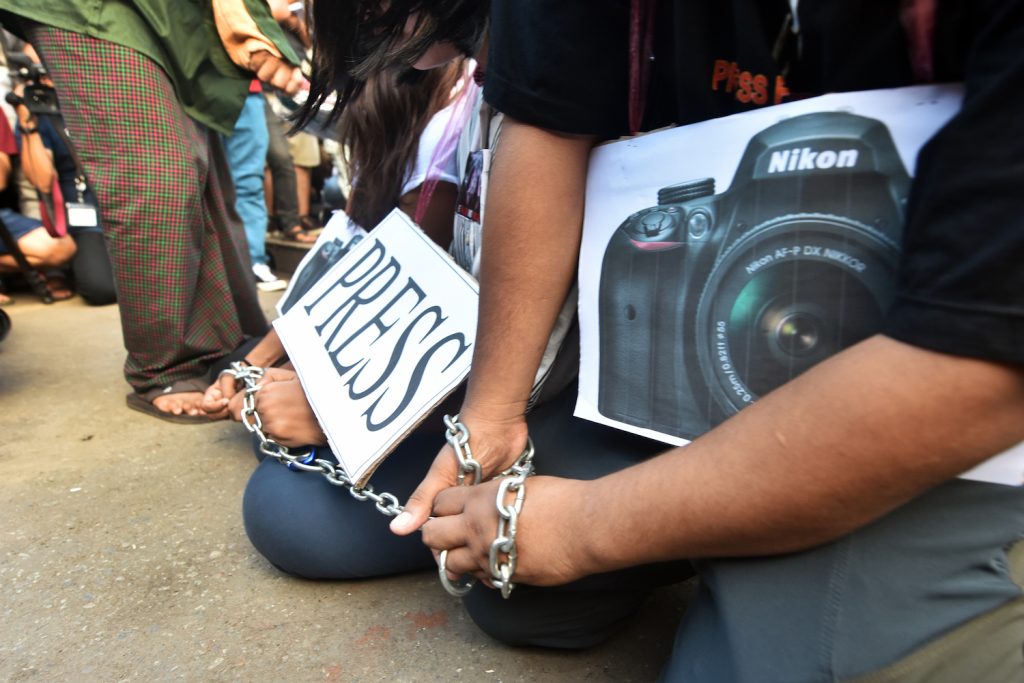
Changing attitudes
Before the coup, the anti-Rohingya sentiment that used to be commonly expressed in print, online and in the community has been undergoing a re-evaluation. A Twitter campaign in June 2021 with the hashtag #Black4Rohingya had people from Myanmar saying they’d been “brainwashed” by Buddhist nationalist rhetoric and committing to supporting the Rohingya going forward.
Burmese-language media and Facebook users can now often be seen referring to the Rohingya by their self-identified name, when previously they would have been referred to with the derogatory term “Bengalis” implying they are illegal immigrants from Bangladesh.
However, the change in attitude from the media is not as widespread as activists would like.
“Although media outlets have changed their editorial position and are now using the word ‘Rohingya’, stories are still fairly rare and are relegated to their foreign affairs coverage of Bangladesh or the Hague,” said Yin Yadanar Thein from Free Expression Myanmar.
Attitudes towards the media itself evolved during the 10 years of improved press freedom, though it wasn’t always towards the positive. For large parts of the NLD reign, media, especially independent media, was seen as an antagonistic force out to undermine both the civilian government and the military.
“For ten years, people in Myanmar have had the opportunity to live in a country where the press was relatively free. This cannot be undone. They have learned to make a difference between government propaganda on one hand, and media outlets which are driven by journalistic ethics on the other. As a result, people just can’t take misleading information seriously anymore, which makes true journalists fundamental allies in providing the public with trustful news,” said Daniel Bastard from Reporters Without Borders on April 21 via email.
Public perceptions shifted following the coup, when the public witnessed the junta targeting journalists. Ko Maung Tha*, a Myanmar man in his early 30s, thinks that people are seeing the journalists in a more positive light.
“I believe the public’s perception of the media has become considerably more positive after the coup, as they are the main source of information that the public is able to see in the ongoing crisis, and due to the dangers the journalists faced to get this information and these sources. The SAC’s demonisation of the free press has really made the journalists look more heroic in the eyes of the public,” he said on April 22.
The senior editor Frontier spoke with said people became more open-minded about consuming media during the years before the coup when press was relatively free. He noted the public’s ability to really question the validity of what they were seeing online only developed after the boom in mobile phones and affordable internet plans which enabled people to get more information and form their own opinion.
“After the coup, it seemed like the media is all the citizens have to depend on to get any sort of news. This was also why the military junta suspended some outlets. And with the changing political landscape in Myanmar, the citizens have grown to trust that the media will be a force which can give them information they can no longer access [from the junta],” he said.
The international community has responded by condemning the attacks on the press in various forums, including a public statement by the Media Freedom Coalition on February 4 this year. It called on the military to “end its obstruction of the right of people in Myanmar to freedom of expression, both online and offline”. The coalition is made up of 29 member states including the US, UK, Australia, Germany, Japan and others.
More can be done, according to Phil Robertson, deputy Asia director for Human Rights Watch, who spoke with Frontier via email on April 22.
“Media freedom activists need to act to make Myanmar a poster child for shoddy, rights abusing treatment of the media, and demand that concerted efforts be made to end this repression.”
*denotes a pseudonym has been used for safety reasons


